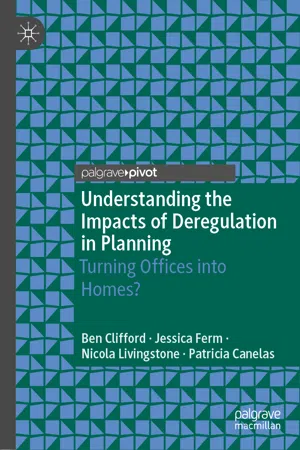Planning and Society
We live in an age of wicked problems, many of them connected to our built environment: the causation of, and response to, climate change; social and spatial inequality; and the challenges of providing decent homes amongst others. In the UK, issues related to housing provision have become the planning issue receiving the greatest attention for some time. Indeed, in political and media discourse, it is not uncommon to refer to there being a ‘housing crisis’, with Prime Minister Theresa May delivering a keynote speech in March 2018 about the ‘national housing crisis’ meaning that ‘in much of the country, housing is so unaffordable that millions of people who would reasonably expect to buy their own home are unable to do so. Others are struggling even to find somewhere to rent’ (May 2018: online).
Although we would argue that planning can potentially play a positive role in helping tackle some of these wicked problems, they are playing out in an age of profound scepticism about planning. For some time in UK society, there has been a ‘planning pessimism’ common in popular discourse (Clifford 2006). This is reflected in a number of different national contexts, where we see a ‘planning phobia’ (Waterhout et al. 2013) so that, as Gunder has argued, planning is now often positioned as ‘the ‘scapegoat’ impediment in opposition to popular aspirations for a superficially better entrepreneurial world without regard to the consequences, such as those created by unfettered growth’ (2016: 22).
This is, perhaps, unsurprising. Town and country, or spatial, planning has long been associated with an image of state intervention and regulation. For some time, however, governments in many places have been hostile to notions of public regulation. In the UK, the 2010–2015 Coalition and current Conservative governments have promised a ‘bonfire of red tape’ and the enforcement of a ‘one-in-two-out’ rule for those seeking to establish new regulation (HM Government 2015). The UK’s departure from the European Union has also been heralded as an opportunity to reduce regulation, although calls to further reduce building and fire regulations have become more muted since the tragic Grenfell Tower fire. In the USA, meanwhile, an executive order implemented in 2017 similarly requires a ‘one-in-two-out’ approach to regulation and President Trump was pictured literally cutting through a piece of red tape with a pair of golden scissors.
Such trends can be understood in the context of the economic and political project of neoliberalisation, which is commonly linked to changes in the regulatory role and capacity of the state. Indeed, arguably neoliberal conviction politics ‘assert that the fiercely competitive economic environment abroad, coupled with deep-seated social problems at home, leave ‘no alternative’ to a course of deregulation, marketization, privatization and public asset-stripping’ (Peck 2001: 445). Such a worldview is unlikely to be sympathetic to planning (see Chapter 2 for further discussion).
It is this frame through which we must understand recent reaction to the ‘housing crisis’ in England. The act of designating something a crisis is, of course, a political act in itself, the constitution of which then provides actors with a reform opportunity, a chance to punctuate routine policymaking (T’hart and Boin 2001). Thus, complex issues of rising property prices, declining affordability, homelessness, housing inequality and public funding are reduced simply to an idea that the housing crisis is all about supply problems which then legitimates a view of ‘a market held back by over-zealous bureaucracy’, in turn supporting calls to reduce planning control (Gallent et al. 2018).
Such
planning reform matters. As Hazel Blears said during a speech in 2008:
Our built environment is never merely functional or utilitarian, but an expression of the values we hold dear, the kind of society we are and aspire to be … Planning matters because it is the means by which we achieve those aims. (Blears 2008: online)
More broadly, Parker (2013) has argued that it is important to pay close attention to regulation because regulating for the public interest has a close relationship to questions of social relationships, opportunities for deliberation and justice, and the boundaries and power relationships between the public and the private.
Such issues lie at the heart of this book. Our central concern is the consequences of planning deregulation. We investigate this though considering changes to the system for governing the control of converting office buildings to residential use in England. Such changes have involved a shift from traditional planning control to a system of ‘permitted development’ (PD). Whilst this focus may appear slightly esoteric, it is a reform which in itself has had significant impacts on public finances and people’s quality of life. It is also, more broadly, an example of the consequences of deregulation in the built environment, which we explore using in-depth, original research data originally collected through research funded by the RICS Research Trust (see Clifford et al. 2018). In this chapter, we consider the context for the specific reforms we are focussing on and outline the structure of the rest of the book.
Permitted Development
In the UK tradition of planning, prior permission—‘planning permission’—is required before development can occur. This normally falls to the local state, the relevant district or borough council being designated the ‘Local Planning Authority’ (LPA) able to consider the principle, location, design and numerous other merits of a proposed development before allowing it proceed (or not). We can understand this as the nationalisation of development rights which occurred through legislation passed in 1947, with the process of determining such planning permission known as ‘development control’ or ‘development management’.
This process of development management is the executive arm of the planning system: the means by which policies and proposals from the plan are implemented. It is (somewhat unusually internationally) also a discretionary process, considering (within a framework of the development plan and national planning policy), the merits of each proposal on a case-by-case basis. In 1984, Haar wrote that ‘the heart of British planning is the permitting system, strengthened by the government ownership of...
